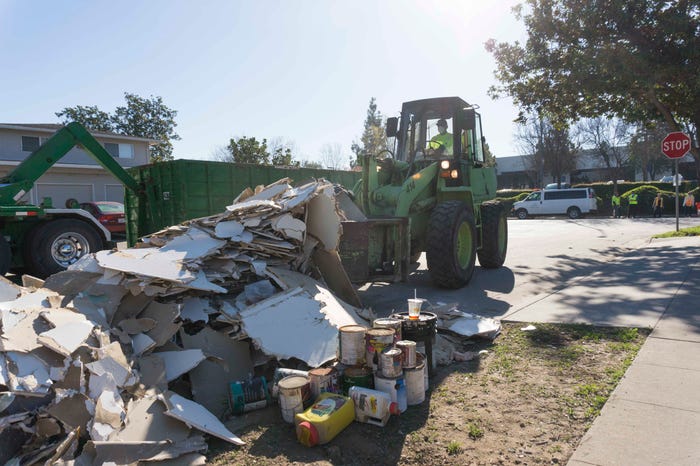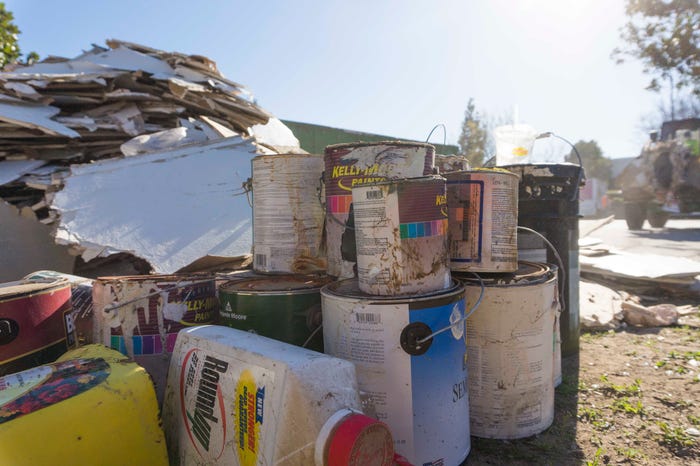How San Jose, Calif., Tackled Cleanup Duties in Flood-Ravaged Neighborhoods
By working with a local hauler, San Jose was able to clean up quickly after a flood disaster.

During what was the rainiest winter in two decades for Silicon Valley, a massive water surge from the largest reservoir in Santa Clara County poured into Coyote Creek on Feb. 21, 2017, flooding three significant areas of the city of San Jose, Calif.
Raging waters poured into neighborhoods forcing the mandatory evacuation of 14,000 residents. Approximately 22,000 more residents were advised to leave their homes as well. The flood waters ravaged neighborhoods causing an estimated $50 million in private property damage, $23 million in public property damage and leaving in its wake nearly $1 million in cleanup costs.
As it turns out, an emergency services contract with GreenWaste Recovery Inc., inked in addition to the exclusive daily residential yard waste contract in San Jose, paved the way for swift action.
“We had emergency services schedule of services and fees in our agreement with GreenWaste already, we just had never used them before, says” Jo Zientek deputy director of San Jose’s Environmental Services Department (ESD).
Emergency personnel asked that the city wait three days to start cleanup so emergency equipment could be used, she says. “But we were ready to go and already had the equipment and the provisions already in the contract to do it immediately."
“I was surprised when I talked to our contact in FEMA, that it wasn’t that common for cities to have those emergency services provisions in their contracts," she adds. "He was surprised that we had it.”
It was helpful to have it all nailed down and ready, she says.
Not all haulers are capable of providing both everyday pickup and emergency services simultaneously, which may be why many jurisdictions forgo these emergency contracts, says Emily Finn, GreenWaste’s director of business development and communications.
“In our case, fortunately, we had the equipment and the drop boxes, the claw loaders the rear loaders and have been able to provide those services," Finn says. "So I think the combination of us having the availability to pull equipment from other areas, combined with the city having us under contract is what enabled us to be ready to deploy the very next day."
Although San Jose-based GreenWaste couldn’t know to what degree certain types of equipment would be needed, it was ready with everything from 40-cubic-yard bins, to rear loaders and compactors, and with what would turn out to be the game changer for the emergency cleanup, its custom built yard waste tractor known as “the claw.”
Because San Jose has a fairly unique loose, in the street yard waste collection program, the company custom built the tractors to fit the collection.
The tractor is fitted with a front claw that opens and closes parallel with the ground. The claw has a scoop in the bottom. The tractor approaches yard waste, opens the claw right to left, and then closes the claw on the yard waste and picks it up. Each claw loader is paired with a rear loader. After each scoop it dumps into the rear loader, the claw is empty again and ready to collect more yard waste.
“It proved absolutely instrumental in the flood cleanup because of ease of use and not having to require anyone to manually handle the materials,” says Finn.
The claw loaders allow a certain finesse in handling the materials that a bucket loader doesn’t. Operators can close the claw around materials and lift them off the ground. With a bucket loader, material inevitably gets pushed away from the tractor, she says. It also works in tight areas and handles everything from construction debris, personal property, furniture and the flood-soaked waste.

“The drivers of the claw loaders are kind of like surgeons,” adds Finn. “They can extract yard trimming between two cars without touching the cars or the curb that you wouldn’t think you could do with a rake. They are very, very talented, so the demand for the claw loaders went up significantly.”
The neighborhoods impacted by flooding were as varied as their needs for services. Because Rock Springs, which is largely comprised of apartments, was under mandatory evacuation, planning was especially difficult. Residents unable to return home for days after the floods couldn’t take advantage of debris removal services. Others couldn’t be home because of work schedules or because they were temporarily staying outside of the city. Some neighborhoods were largely non-English speaking, which sometimes slowed communications.
Fine tuning daily resources and communicating with residents and with other city departments—like the Department of Planning, Building and Code Enforcement that organized volunteers and oversaw distribution of bins and equipment—was a necessity. Zientek says staff did a lot of knocking on doors the night before letting residents know when and where to put materials out for service. It meant being very flexible, she says.

“And that’s where the emergency contract helped us because we were able to try something in the morning and literally if it didn’t work try something different at night,” she says.
ESD also worked to dispose of household hazardous waste following the floods. Fortunately, because hazardous waste often is included with illegally dumped items, in July, ESD formed a four-person Illegal Dumping Rapid Response Team made up of workers certified for handling hazardous waste.
“So when the flood came, we actually were able to handle most of the hazardous waste," Zientek says. "We collected about 63,000 pounds just in these neighborhoods. We were able to do that in house because I just happened to have this internal resource that we had just brought on and trained just nine months ago. So that was also very helpful because the hazardous household waste had to be collected parallel to everything else.”
In total through March 13, GreenWaste filled 378 40-yard debris bins at more than 500 housing units that were damaged, using as many as 11 claw loaders per day. As of last week, the city collected 1,466.98 tons of debris and hauled it to the Newby Island Landfill.
As of Monday, the total items removed were: nearly 6,000 gallons of paint, oil, flammables and miscellaneous liquid toxics and more than 20,000 pounds of solid toxics, including batteries, e-waste and fluorescent tubes.
Cleanup is coming to a close and heading toward the construction and demolition phase of the work, says Zientek. Residents will be working with any of 27 C&D contractors around the city who are ready to do the work, she says.
Though original cleanup estimates were as high as $3 million, Zientek says it is more likely to end up costing less than $1 million. The city is collecting cost information and submitting it through emergency management reimbursement channels to the state.
“We are planning on most of it getting covered” she says.

About the Author
You May Also Like


